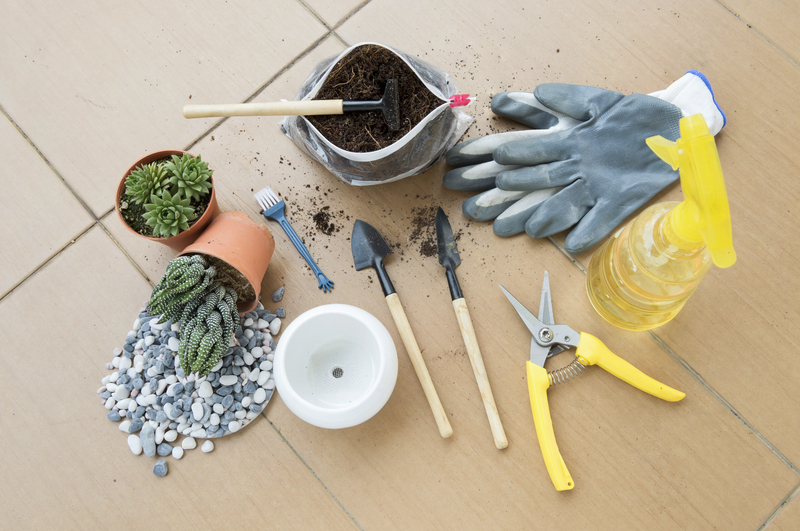Cultivating Change: How Gardening Helps Tackle Climate Change
Posted on 29/06/2025
Cultivating Change: How Gardening Helps Tackle Climate Change
In a world facing rising emissions, urban sprawl, and shrinking green spaces, the humble act of gardening offers powerful solutions. Discover how nurturing your backyard or balcony can become a frontline defense against climate change, while also supporting biodiversity, healthier communities, and a sustainable future.
Understanding the Connection: Gardening and Climate Change
Climate change is one of the greatest challenges humanity faces--affecting ecosystems, economies, and societies worldwide. While governments and industries debate policies and technologies, individuals often feel powerless. However, gardening for the environment presents a practical way for anyone to make a tangible difference.
So, how do small gardens and landscaping impact our planet?
- Absorbing and storing atmospheric carbon
- Enhancing biodiversity and resilience
- Reducing urban heat islands
- Improving soil health
- Helping communities adapt to climate change effects
Key Terms to Know
- Carbon Sequestration: The process of capturing and storing atmospheric carbon dioxide (CO2).
- Biodiversity: The variety of living plants, animals, and microorganisms.
- Sustainable Gardening: Practices that meet present gardening needs without compromising future generations' ability to garden sustainably.

Why Gardening for Climate Change Works: The Science Behind the Soil
Plants are powerful allies in the fight against climate change. Through photosynthesis, they capture carbon dioxide--a major greenhouse gas--converting it into oxygen and organic matter. When you practice eco-friendly gardening, you increase this capacity for carbon capture and storage.
- Trees, shrubs, and perennials store carbon in their woody tissue for decades.
- Healthy soils lock away organic carbon, reducing atmospheric CO2 over time.
- Mulching and composting improve soil structure and increase its carbon-holding capacity.
How Your Garden Absorbs CO2
The more vigorously you cultivate trees, deep-rooted grasses, and shrubs, the more carbon your garden can sequester. Not only does this directly remove greenhouse gases from the air, but it also enriches the soil, which is often depleted by conventional agriculture and urban landscaping.
Cover Crops and Carbon Storage
Planting cover crops (like clover or vetch) during the off-season protects soil from erosion and helps boost its carbon content. These plants also suppress weeds, reduce the need for chemical fertilizers, and promote beneficial microorganisms in the soil -- all of which further climate resilience.
Gardening for Resilience: Adapting to Climate Change
While gardening helps reduce climate change impact by absorbing CO2, it also prepares communities for climate change adaptation.
- Rain gardens and bioswales reduce flooding by capturing and filtering stormwater runoff.
- Xeriscaping (using drought-tolerant plants) conserves water in dry regions.
- Community gardens boost local food security amid climate disruptions.
Harvesting Rainwater and Managing Water Sustainably
Using rain barrels, swales, and permeable landscaping helps recharge groundwater, reduce pollution, and prepare for irregular rainfall patterns. These methods not only support your garden but also mitigate urban flooding and support broader climate resilience.
Enhancing Urban Environments: Gardens vs. the Urban Heat Island Effect
Cities are often several degrees warmer than surrounding areas due to the urban heat island effect. Pavement and dark roofs absorb and re-radiate heat, while a lack of greenery prevents cooling.
- Rooftop gardens and green walls provide shade, insulate buildings, and cool the air through evapotranspiration.
- Tree-planting programs create shaded streets and parks, reducing local temperatures and the need for air-conditioning.
- Lawns and gardens replace heat-absorbing hard surfaces with moisture-rich, cooling plants.
Community Gardens in Urban Areas
Community gardens turn vacant lots and rooftops into green oases. They not only reduce climate change impact but also build social cohesion and provide fresh food in underserved areas.
Boosting Biodiversity and Wildlife
Biodiversity is one of our greatest buffers against climate extremes and ecological collapse. Gardens--when planted with native species and designed to avoid chemicals--become valuable habitats for pollinators, birds, and beneficial insects.
- Native plants strengthen local ecosystems and require less water and fertilizer.
- Organic gardening avoids synthetic pesticides and fertilizers, which can harm the soil and disrupt carbon cycling.
- Wildlife-friendly gardens support bees, butterflies, birds, and bats--all vital for ecosystem health and crop pollination.
Pollinator Pathways: Connecting Habitats
Neighborhood gardens can link together, forming green corridors for pollinators and other wildlife, allowing them to move safely and adapt as the climate changes.
Gardening as a Climate Action: Steps You Can Take
Anyone with a patch of soil or a few containers can make a difference. Here are practical steps to garden for climate change mitigation:
1. Grow More Perennials and Trees
- Plant native trees, shrubs, and long-lived perennials to lock away more carbon.
- Replace some lawn areas with diverse, deep-rooted plants.
2. Compost Organic Waste
- Composting food scraps and yard trimmings turns waste into rich soil--reducing methane emissions in landfills and improving soil carbon content.
3. Use Mulch and Avoid Bare Soil
- Mulch prevents erosion, retains moisture, keeps soil cool, and gradually adds organic matter.
4. Avoid Chemical Fertilizers and Pesticides
- These products often require fossil fuels to make and can disrupt natural soil ecosystems that store carbon effectively.
5. Start or Support a Community Garden
- Collectively, community gardens offset more carbon, reduce food miles, and engage more people in climate-friendly practices.
6. Practice Water-wise Gardening
- Collect rainwater, use drip irrigation, and incorporate drought-tolerant landscaping (xeriscaping) to save precious resources.
7. Plant for Pollinators
- Grow a variety of nectar-rich native flowers throughout the growing season to support bees, butterflies, and other pollinators.
8. Share Knowledge and Inspire Others
- Host garden tours, workshops, or social media posts to spread the word about climate-resilient gardening.

The Future of Climate-Smart Gardening
Climate change is altering weather patterns, cropping zones, and pest populations--so gardeners must adapt as well. Climate-smart gardening involves:
- Choosing plant varieties suited to your changing local climate
- Propagating resilient or drought-tolerant species
- Experimenting with new crops as hardiness zones shift
- Fostering a culture of observation and flexibility
Tools and Technology for Sustainable Gardening
Modern tools--such as soil sensors, weather monitoring apps, and smart irrigation--can help home gardeners save water, optimize growing conditions, and reduce carbon footprints even further.
Gardening's Broader Impact: Social and Psychological Benefits
A garden isn't just a carbon sink; it nurtures the gardener. Exposure to green spaces and hands-in-soil activities have been shown to:
- Reduce stress and support mental well-being
- Build a sense of connection and stewardship toward nature
- Foster community engagement and cohesion
- Encourage healthy eating through homegrown produce
These benefits help people and neighborhoods become more resilient--not only to climate change, but to everyday challenges.
Conclusion: Every Garden Counts in the Fight Against Climate Change
Cultivating change begins in your own backyard, balcony, or window box. By embracing sustainable, climate-friendly gardening, we can all participate in the restoration of our planet's environment. From carbon sequestration and biodiversity support to urban cooling and food resilience, gardens offer hope and practical action in the face of a warming world.
Whether you're a seasoned gardener or just beginning, remember that every plant makes a difference. Together, our gardens can grow a greener, more resilient world--one seed at a time.
Additional Resources for Climate-Change Gardening
- Royal Horticultural Society: Gardening and Climate Change
- Garden Organic: Climate-Friendly Gardening
- EPA: Using Trees and Vegetation to Reduce Heat Islands
Start cultivating change today--your garden is more powerful than you might think.

